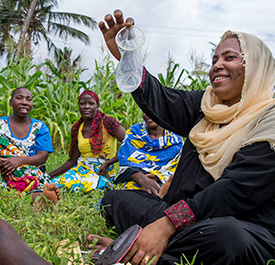In July 2022, the global family planning community will celebrate the 10-year anniversary of the London Family Planning Summit and the launch of the Family Planning 2020 (FP2020) partnership. The last decade has seen remarkable increases in access to and use of family planning across sub-Saharan Africa (SSA), with the largest global gains in contraceptive prevalence concentrated in this region.1 Despite initial fears that the COVID-19 pandemic would stall or reverse progress, evidence suggests that family planning programs across SSA were resilient to pandemic disruptions.2
As the family planning community rallies around the launch of the FP2030 partnership, it is important to recognize that the population of women of reproductive age in SSA increased by 66 million over the last decade and is projected to continue growing over the next decade. Advancing person-centered, rights-based family planning programs that meet the reproductive needs and preferences of women and couples in the region will require continued adaptability, innovation, and resilience, and a commitment to ensure equitable, high-quality services characterized by greater accountability and local leadership.
This report examines the status of family planning programs in 22 countries in SSA over the last five years, since the 2016 release of Fostering Economic Growth, Equity, and Resilience in Sub-Saharan Africa: The Role of Family Planning.3 Selected countries are those primarily identified by USAID as Family Planning Priority Countries in Africa, as well as several countries in the Ouagadougou Partnership. We build and expand on themes explored in the 2016 report to better understand progress and challenges that may shape the trajectory of family planning and inclusive development in the region for the decade to come. The current report complements analyses released under the global FP2020 and FP2030 partnerships, such as the annual progress reports and the 2021 Measurement Report, and resources guiding USAID program investments such as the Family Planning High Impact Practices.
Key takeaways of our report include:
- Modern contraceptive use is increasing across SSA. Most USAID priority countries have reached a stage where accelerated growth in contraceptive uptake is possible if decisionmakers commit to strategic programmatic investments.
- Countries with high and/or increasing modern contraceptive prevalence rates (mCPR) have made robust programmatic investments in data collection and use, suggesting the essential role data and evidence play in programs supporting access to family planning.
- The COVID-19 pandemic’s impact on family planning use does not appear to be as severe as originally feared. The pandemic has underscored the importance of timely data collection and management systems that are resilient to shocks.
- In many countries in SSA, declines in fertility following growth in mCPR use continue to be smaller than historical trends in other regions of the world, due in large part to the use of family planning for spacing rather than limiting births. While shifts toward limiting births may be underway, policymakers should carefully consider the assumptions that underlie their demographic projections—which are often based on global trends—as well as the implications of increasing and varied family planning demands on health systems and social infrastructures, particularly education, training, and employment.
- Significant disruptions in education during the pandemic—especially for girls—and subsequent high rates of teenage pregnancy underscore the urgent importance of collaboration between the health and education sectors to mitigate effects on girls’ well-being.
- Increases in mCPR are being driven not just by improvements in women’s socioeconomic status but also by factors such as family planning program efforts.
- Differences in population age structure are a major contributor to between-country trends in economic inequality in the region. If current fertility trends continue or accelerate, age structure change can contribute to a positive economic convergence, in which countries become more economically equal over the next two decades.
- At the same time, differences in family size between the richest and poorest segments of the population are contributing to resource inequality among children within countries, slowing the next generation’s progress toward equality of opportunity.
- It is urgently necessary to prioritize more equitable, data-driven, and people-centered family planning programming that is responsive to the needs and preferences of individuals.
- Family planning program efficiencies must be improved to maximize scarce resources. Creating a culture of continuous use of data for decision-making and scaling up effective digital solutions can contribute to more efficient program prioritization and implementation.
The report is broken into six sections.
- Section 1 introduces the report and summarizes the key takeaways.
- Section 2 explores family planning program progress, particularly increases in mCPR, in SSA since the 2016 report.
- Section 3 explores how trends in mCPR may influence trends in fertility, highlighting patterns unique to SSA.
- Section 4 examines the extent to which family planning programs have reached women regardless of economic status, enriching our understanding of whether poverty is affecting family planning use.
- Section 5 complements the analysis of poverty by examining the relationship between family planning, fertility trends, and socioeconomic inequality both between and within countries in SSA.
- Section 6 proposes future directions for family planning decisionmakers to prioritize during the next decade.
